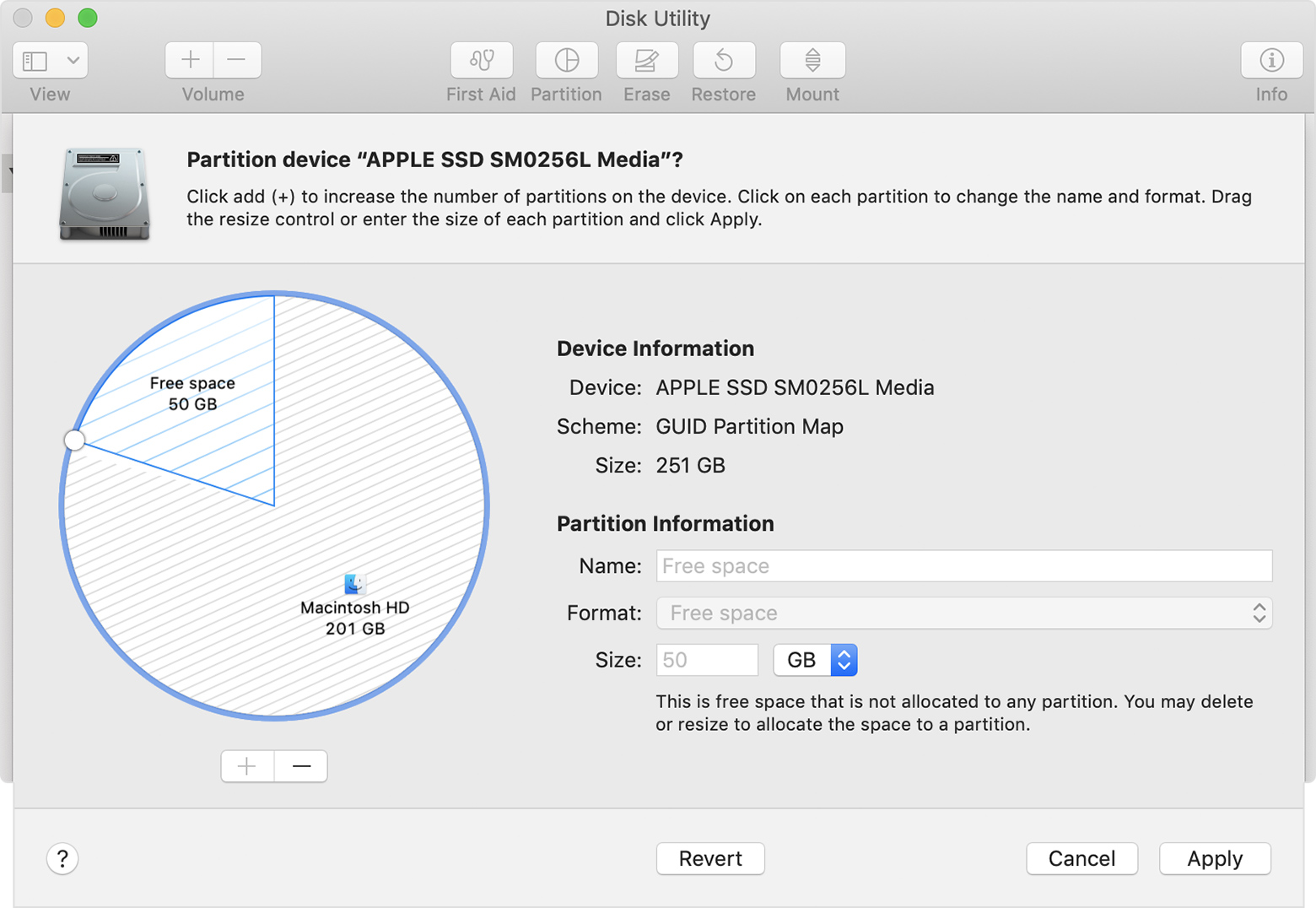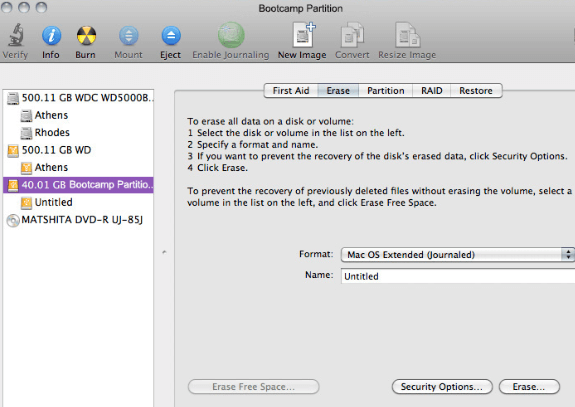How To Access Mac Partition On Boot Camp
Learn how to use Boot Camp on an external drive and what you need for an external Windows drive, such as disk utility, terminal, boot camp assistant. Your source for expert tips, special deals, commentary, reviews, and the latest tech news. Oct 07, 2019 If you have previously partitioned your Mac's hard drive in order to download a macOS beta or install Windows, but now you need that storage space back, you can remove the partition and recapture the much-needed space.Here's how. Getting rid of a secondary partition on the Mac. It prevented users from accessing the Mac OS X partition while logged into Windows Bootcamp. If you wish to have access again to your Mac OS partition via Bootcamp without installing third party apps, you will have to switch from Core Storage back to HFS+. The process is pretty simple without loss of data but just create a backup should in case.

If you own Intel-based Macs, you can run OS X and Windows on one machine. In fact, it’s been possible to run Windows on a Mac for some time — with agonizing limitations. Near-extinct Mac models were loaded with Virtual PC emulation software could do Windows, too, but the program was painfully slow. Even if you find an old copy of the software, it won’t work with any current Macs.

Boot Camp software from Apple shook up the computing public upon its apocalyptic arrival in April 2006. Boot Camp graduated from beta, or near-finished, status with the arrival of Leopard. Boot Camp Assistant software is stored in the Utilities folder inside the Applications folder.
Boot Camp itself is free. You have to supply your own single-disc or downloadable full-install version of Windows; an upgrade disc won’t cut it.
It’s also important to note that you can use a 64-bit version of Windows, Windows 7 (Home Premium, Professional, or Ultimate), Windows 8, or Windows 8.1. Consult Apple support to see which Mac models are compatible with which versions of Windows. In its current incarnation, Boot Camp isn’t compatible with 32-bit versions of Windows.
Other requirements follow:
An Intel Mac with OS X version 10.6 or later
At least 2GB of RAM and 20GB of available space on the Mac’s storage drive that you want to donate to Windows
A blank CD or USB storage device that you’ll use for Windows software drivers
If you don’t run into snags, the entire installation should take about an hour.
Windows 8 and Windows 8.1 are optimized for a touchscreen environment, though you can use it with a standard mouse and keyboard. For now, Macs don’t support touchscreen computing.
To install Windows 8 via Boot Camp, you still must have a legitimate Windows 8 license from Microsoft and a Win8 installation disc, assuming that you have an optical drive. If you don’t have an optical drive, you may be able to create a Windows installer from an ISO file downloaded from Microsoft on a USB flash drive that’s 8GB or larger.
Because snags are possible, back up all your important information on the Mac’s startup disk.
Basic training
Following are the basic steps to get through Boot Camp:
Run Boot Camp Assistant (in the Utilities folder inside the Applications folder) to make sure that you have the latest firmware on your computer and to install any support software from Apple that you might need.
You’ll find any updates at Apple support. If you’re using a portable computer, make sure to connect the power adapter. You will also be given the option to create a Windows 7 (or later version) install disk for which you’ll need a USB flash drive and an ISO image downloaded from Apple.
Stylus RMX Xpanded is an award-winning, industry standard groove-based virtual instrument plug-in. Ummet Ozcan – Genesis Pro For Windows Free Download. In Audio Plugins, Mac, Windows. Plugin Boutique Scaler v1.8.0 (Win & Mac). VST Audio Plugins search engine. We do not store any files, we just search it, index it and make it easier for. Mar 29, 2020 Stylus RMX 1.9.8.c Crack Full Version Download Free. Stylus RMX Crack 1.9 excellent DAW-based designed software with a Built-In Media Player in which every Music Composer generates Music files, Increased Volume Level & other Effects Insert. Free vst plugins download windows 10. Apr 04, 2020 After all, we tirelessly scoured the web to bring you the best free VST plugins out there on the market. Rightly so, Virtual Studio Technology (VST) plugins or VST instruments are an essential element every music production enthusiast needs to craft and hone their soundscape with to add rich audio effects and get that solid final mix. Stylus RMX VST Crack v1.9.8g + Keygen (Mac) Free Download. Stylus RMX Crack 1.9.8g Mac excellent DAW-based designed software with a Built-In Media Player in which every Music Composer generates Music files, Increased Volume Level & other Effects Insert. It is an interesting “Media Files Creation” based designed software that Synchronizes the user every single keystroke without taking left.
Follow the prompts in Boot Camp Assistant to create a partition for Windows.
You’re essentially carving out an area of your hard drive for the Windows operating system,. This partition must be at least 30GB and can swell to the total free disk space on hand minus 30GB. If you don’t plan on doing much in Windows, keep the partition small.
Drag the divider to set the partitions for both OS X and Windows, or click Divide Equally to make equal partitions. You can’t resize a Windows partition after creating it, though you can replace it with a larger Windows partition.
If you have a Mac Pro with more than one internal hard drive, you can select which drive to partition. If any of this makes you nervous, know that you can remove the Windows partition later and go back to a single-partition Mac.
Insert the Windows CD or a USB flash drive with the Windows ISO file and then click Start Installation.
If you exited Boot Camp Assistant before installing Windows, open it again, choose Start the Windows Installer, and click Continue.
When you’re asked to choose the Windows partition, select the partition that says BOOTCAMP.
You may have to scroll down to see it.
Don’t erase any partitions that you see or create a new partition here. Failure to heed this warning could wipe out your entire Mac OS X startup disk.
The links are provided solely by this site’s users. Falcon vst crack. The administrator of this site (VSTMania.com) cannot be held responsible for what its users post, or any other actions of its users. The Links and other content of the site is shared solely by this sites’s users. You may not use this site to distribute or download any material when you do not have the legal rights to do so. None of the files shown here are hosted or transmitted by our server.
(Optional) If you see a listing for Drive Options, click it; otherwise, proceed to Step 6.
Reformat the partition by using the Windows installer: Click Format.
You’re using the reliable and secure NTFS file system, but you won’t be able to save files to Windows from Mac OS X, at least not without a techie workaround.
Follow the onscreen instructions to finish installing Windows.
Boot Camp 5.1 includes several Mac drivers so that Windows will recognize your trackpad, Thunderbolt, USB 3.0, the iSight (or FaceTime) camera, the Eject key on the Mac keyboard, networking, audio, graphics, and so on.
A Boot Camp Control Panel for Windows and an Apple Boot Camp system-tray item will be added.
As with any new Windows computer, Microsoft requires that you activate your Windows software within 30 days.
Switching operating systems
You can go back and forth between OS X and Windows on your Mac, but you can’t run both operating systems simultaneously under Boot Camp. Instead, you have to boot one operating system or the other — thus, the name Boot Camp.
Restart your Mac, and hold down the Option key until icons for each operating system appear onscreen. Highlight Windows or Macintosh HD, and click the arrow to launch the operating system of choice for this session.
If you want OS X or Windows to boot every time, choose app → System Preferences, click Startup Disk, and choose the OS you want to launch by default.
You can perform the same function in Windows by clicking the Boot Camp system-tray icon and selecting the Boot Camp Control Panel. Click either the Macintosh HD or Windows icon, depending on your startup preference.
Increase Boot Camp Partition
If you are using the Boot Camp utility or another Windows emulator on your MacBook, you will need to switch between your Mac OS X and Windows systems. There are three methods of switching back and forth between your Mac OS X partition and your Windows partition:
How To Access Mac Partition On Boot Camp Mac
From within Mac OS X Lion: To restart your MacBook in Windows, click System Preferences in the Dock and click the Startup Disk icon to display the settings you see here.
Click the Windows partition you created in the list to select it (the folder icon will bear the Windows logo, and it will be labeled Windows as well). Click Restart, and then click Restart again when asked for confirmation. Your laptop reboots and loads Windows, and it continues to run Windows when started or rebooted until you follow one of the next two methods of returning to Mac OS X.
From within Windows: Right-click the Boot Camp icon in the notification area at the right side of your Windows taskbar — it looks like a slanted square — and choose Restart in Mac OS X. Again, you’ll be asked to confirm your choice. After you click OK, your MacBook reboots and returns to Lion.
During the boot process: Need a temporary fix from your other operating system? You can reboot from within either Lion or Windows and hold down the Option key when you see the Apple logo appear. Your Mac displays a nifty row of icons, each of which represents a bootable operating system that your Mac can use.
To boot Mac OS X, click the Lion partition icon. To choose Windows, click the Windows partition icon. Note that when you turn on or reboot your Mac, it returns to the operating system you last selected in the System Preferences Startup Disk pane.